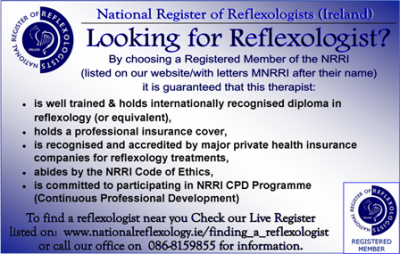LOOKING FOR REFLEXOLOGIST? >>CLICK HERE>>
Pain
Management in Reflexology
(Carol Samuel,
PhD. Cert-Ed, MAR, FFHT)
Although pain is valuable to us because
it tells us of impending danger; in its chronic form it serves no useful
purpose but it nonetheless affects millions of people worldwide with
significant implications on quality of life and on the resources of the medical
profession 1 2. In today's society it appears to be a general
consequence of ageing and ill health, thus producing devastating effects for
sufferers and their families. Pain is
not however a simple sensory experience; it is also an emotional, social and
cognitive one in which it can affect a person's attitude, belief and appraisal
of pain.
It is described by the International
Association for the Study of Pain (IASP) as
an unpleasant sensation that may be linked to potential or actual tissue
damage, and which may possess both physical and emotional experiences. In
short, pain is often difficult to describe and sometimes the terminology used
cannot, and does not provide justice to the actual pain experience. There are
no objective measurements available for pain, no regular blood tests or
dipstick tests and that means that it is an extremely personal phenomenon which
can be described only by the person experiencing it 2
3.
In
the UK
more than 49% of the population experience back pain in any given 12 month
period; approximately 90% of these episodes will fix themselves within 6 weeks 4. Nonetheless, pain conditions lasting longer
than 3 months (chronic pain) are becoming increasingly difficult to treat and
the choice of drug combinations provided in general practice can vary according
to the type, location and a patient's personal attitude toward pain
relief. The general rule is to provide
pain relieving analgesics at the lowest level appropriate to the patient's
pain, and then to move on to a higher potency level until the required relief
is obtained 5-7.
Patients'
may climb the so called ‘analgesic ladder' until they reach a point where they
may require a strong opioid-type drug before they acquire any benefit in terms
of pain relief. Alongside this however
they may have fears about addiction,
tolerance and the lingering side effects of these drugs. Many are still not receiving adequate
pain control and this, unfortunately, has its own set of consequences, not
least of which are sleeplessness (65% of pain sufferers) depression (49%), fear
and stress 2
8. Lack of sleep from stress has an effect on
the regulation of our immune cells and their function, which means that chronic
pain can severely affect the immune system 9-11. Stress increases the release of
adrenocorticotropic hormones (ACTH) that create metabolic and hormonal changes,
further escalating the pain cycle 12
13. Moreover, because chronic pain is known to
induce depression there may be further increases in stress levels 14.
This continual cycle of stress and pain influences immune suppression through
the exaggerated release of pro-inflammatory markers 14-17 which in turn decreases the number of natural killer cells that play a major
role in the rejection of tumours and cells infected by viruses 16.
Patients
often have preconceived expectations of pain, particularly if they have had
previous experience of pain either personally or through having cared for
someone in pain 18
19. Preconception is associated with negative
expectations and when pain control is difficult to achieve it can induce
negative attitudes 20. There is no consistency in pain management
across the UK and many primary care facilities lack sufficient funding to be
able to offer a variety of services.
Those that do, are unable to keep up with the number of referrals 2.
This may all sound rather complex but the science
behind chronic pain is not as complicated as it may seem. Many pain sufferers seek alternative or
complementary means of pain relief and reflexology
is just one of the many modalities available to them. We all know that reflexology can be an
extremely pleasurable experience but were you aware that pain and pleasure are
highly interconnected within the dopamine and endogenous opioid systems of the
brain? 21-23 During noxious
(harmful) stimulation an area of the brain known as the Nucleus Accumbens
releases endogenous opioids into the hypothalamus which helps to raise the pain
threshold 23. My research clearly showed that reflexology
stimulation (which may be perceived as painful by some clients) increases both
pain threshold and pain tolerance 24.
In
addition to the pain relieving effects of reflexology, my research also showed
that reflexology produces a decrease in heart rate, which suggests that it may
also have a beneficial effect on relaxation and stress, and consequently on the
immune function. Whilst reflexology has
shown some measureable differences, demonstrating this effect to clients in a
meaningful way may be elusive to some practitioners. Understanding the basic neurophysiology of
nociception (pain processing) and providing an effective treatment is important
for practitioners; knowing how to measure your clients' pain is vital when a
client cannot clearly see the benefits of your treatment. Evidence shows that emotional responses are
based on motivation and reward 25-27,
so in order for your client to truly appreciate the difference your treatment
is making, you need to show them. You
can do this by measuring the effectiveness of your treatment, based on your
clients' feedback and through the use of pain measurement tools.
My
workshop offers you an introduction to Pain Management, it will cover
nociception, the use of scales to measure your client's pain, and an
introduction to some of the basic Nerve Reflex Points (NRP) for managing neck
and back pain. This workshop is also a
great precursor for those of you who wish to further progress your pain
management techniques with the use of nerve reflex point therapy taught by Nico
Pauly, a Belgian physiotherapist and pain specialist. For further information on NRP, visit my
website www.reflexmaster.co.uk and follow the link under the Reflexology tab or go to http://www.mnt-nr.com/EN/fiche.asp?itemnr=1471.
REFERENCES:
1. Niv
D, Kreitler S. Pain and Quality of Life. Pain
Practice 2001;1(2):150-161.
2.
Donaldson L. Pain: Breaking through the Barrier. In: Basler M, editor. Pain News. London: British Pain Society,
2009:21-27.
3.
Bandolier. Acute Pain - Evidenced Based Healthcare. Bandolier Extra, 2003:1-22.
4.
The Backcare Charity. Facts and Figures, 2014.
5.
Dickensen AH. Pain Mechanisms: Introduction to the Neurophysiology of Pain,
Peripheral and Central Mechanisms [DVD]: British Pain Society, 2008.
6.
Greene RJ, Harris ND. Pathology and
Therapeutics for Pharmacists. London: Pharmaceutical Press, 1993.
7.
Schug SA. Update on the Role of Non-Opioids for Postoperative Pain Treatment. Best Practice and Res Clin Anaes. 2007;21(1):15-30.
8.
Phillips CJ. The Cost and Burden of Chronic Pain. Reviews in Pain 2009;3(1):2-5.
9.
Markenson JA. Mechanisms of Chronic Pain. Am
J Med 1996;101 (suppl 1A):1A-6S - 18S.
10.
Page GG, Ben-Eliyahu S. The Immune-Suppressive Nature of Pain. Semin Oncol Nurs 1997;13(1):10-15.
11.
Tang NKY. Insomnia Co-Occurring with Chronic Pain: Clinical Features, Interaction, Assessments
and Possible Interventions. Reviews in
Pain 2008;2(1):2-7.
12.
Ahles T, Cassens H, Stalling R. Private Body Consciousness, Anxiety and the
Perception of Pain. J Behav Ther Exp Psy 1987;18(3):215-222.
13.
Henry JP. Biological Basis of the Stress Response. Integr Phys Beh Sci 1992;27(1):66-83.
14.
Irwin MR, Miller AH. Depressive Disorders and Immunity: 20 Years of Progress and Discovery. Brain Behav Immun 2007;21:374-383.
15.
Aggarwal BB, Shishodia S, Sandur SK, Pandey MK, Sethi G. Inflammation and
Cancer: How Hot Is the Link? Biochem Pharmacol 2006;72:1605-1621.
16.
Irwin MR. Human Psychoneuroimmunology:
20 Years of Discovery. Brain Behav
Immun 2008;22:129-139.
17.
O'Connor MF, Bower JE, Cho HJ, Creswell JD, Dimitrov S, Hamby ME, et al. To
Assess, to Control, to Exclude: Effects
of Biobehavioural Factors on Circulating Inflammatory Markers. Brain Behav Immun 2009;doi:10.1016/j.bbi.2009.04.005.
18.
Cioffi D. Beyond Attentional Strategies: A Cognitive-Perceptual Model of
Somatic Interpretation. Psychol Bull 1991;109(1):25-41.
19.
Coghill RC, MacHaffie JG, Yen YF. Neural Correlates of Interindividual
Differences in the Subjective Experience of Pain, 2003.
20.
Wiech K, Ploner M, Tracey I. Neurocognitive Aspects of Pain Perception. Cell Press (Review) 2008;Articles in
press:1-8.
21.
Bufalari I, Aprile T, Avenanti A, DiRusso F, Agliotti SM. Empathy for Pain and
Touch in the Human Somatosensory Cortex. Cereb
Cortex 2007;2007(17):2553-2561.
22.
Urch C. Normal Pain Transmission. Rev
Pain 2007;1(1):2-6.
23.
Leknes S, Tracey I. A Common Neurobiology for Pain and Pleasure. Nature Neurosci 2008;9:314-320.
24.
Samuel CA, Ebenezer IS. Exploratory Study on the Efficacy of Reflexology for
Pain Threshold and Tolerance Using an Ice-Pain Experiment and Sham TENS
Control. Comp. Ther. Clin. Pract 2013;19:57-62.
25.
Esch T, Stefano GB. The Neurobiology of Pleasure, Reward Processes, Addiction
and Their Health Implications. Neuroendocrinol
Lett 2004;25(4):235-251.
26.
Ford G, Finn DP. Clinical Correlates of Stress-Induced Analgesia: Evidence from Pharmacological Studies. Pain 2008;140:3-7.
27.
Becerra L, Borsook D. Signal Valence in the Nucleus Accumbens to Pain Onset and
Offset. Eur J Pain 2008;12:866-869.


 Our Objectives
Our Objectives CPD Programme
CPD Programme




